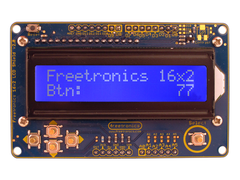Whether you need to double-check if your flatmate drank all the milk, re-enacting the CIA interrogation scenes from "Night Flight to Moscow", or just for fun - having your own polygraph machine could be very useful. Naturally a real one would cost thousands, however as always you can make your own version with an Arduino board and some tin foil (for the sensors, not a hat). The design is quite simple as it measures the conductivity of skin (and sweat...) and returns the value via analog inputs, which can then be graphed on a PC using Processing:

The theory is that conductivity is proportional to the level of deceit. Your milage may vary. Nevertheless, you can find the instructions and Arduino code over at the Mad Science site. An ideal base for your polygraph and other projects is our Freetronics Eleven - the Arduino-Uno compatible with low-profile USB socket, onboard prototyping space and easy to view LEDs:























